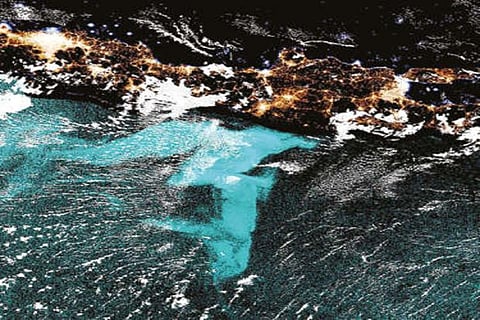

Chennai
Charles Darwin, as he sailed near South America on a dark night aboard the H.M.S. Beagle, encountered luminescent waves. He called it “a wonderful and most beautiful spectacle.” As far as the eye could see, he added, “the crest of every wave was bright” — so much so that the “livid flames” lit the sky.
Now, scientists report that ocean bioluminescence can be so intense and massive in scale that satellites orbiting five hundred miles high can see glowing mats of microorganisms as they materialise in the seas. Last month in the journal Scientific Reports, eight investigators told of finding a luminous patch south of Java in 2019 that grew to be larger than the combined areas of Vermont, New Hampshire, Massachusetts, Rhode Island and Connecticut. “It was an epiphany,” said Steven D. Miller, lead author on the bioluminescence study and a specialist in satellite observations at Colorado State University. When a hidden wonder of nature comes to light, he added, “it captures your imagination.”
The scientists said the close examination of images gathered between December 2012 and March 2021 from a pair of satellites let them identify a dozen extremely large events — approximately one every eight months. Even the smallest was a hundred times larger than Manhattan.
The imagery is opening a new window on the world’s oceans, scientists say, and promises to aid the tracking and study of the glowing seas, whose origins are poorly understood.
Kenneth H. Nealson, a pioneer of bioluminescence research at the University of Southern California, called the discovery “a big step toward being able to understand” how an enduring mystery of the sea “actually comes to be.” The new paper noted that the large concentrations of living lights have long “eluded rigorous scientific inquiry, and thus little is known about their composition, formation mechanism, and role within the marine ecosystem.” Sea bioluminescence is often associated with gruesome creatures of the inky deep. One iconic illuminator is the anglerfish, which dangles bright lures in front of needle-like teeth. In contrast, the luminous seas appear to originate when many trillions of tiny bacteria light up in unison.
Dr. Nealson, and colleagues reported in 1970 that dilute suspensions of a particular type of bacteria emit no gleam. If allowed to multiply, however, the microbes can suddenly light up as if a switch were thrown. Scientists now theorise that the glittering masses of bacteria lure fish, whose guts provide nourishing habitats.
Dr. Miller’s trail of discovery began nearly two decades ago when a lunchtime chat raised the question of whether sea bioluminescence might be visible from space. While working at the U.S. Naval Research Laboratory in Monterey, Calif., in 2004, he began examining imagery from a weather satellite. Soon, he spotted in the northwestern Indian Ocean what turned out to be a glowing patch that was nearly the size of Connecticut. The blurry area was barely visible, but Dr. Miller and his colleagues grew quite excited because they knew that a new generation of satellite sensors would soon provide much greater sensitivity and sharpness. The improved sensors debuted on a pair of satellites launched by the National Oceanic and Atmospheric Administration in 2011 and 2017. The sensitive detectors proved adept — at least on dark nights — at capturing glimmers of light from the seas and provided the imagery for the current report.
The writer is a science reporter with NYT©2021
The New York Times
Visit news.dtnext.in to explore our interactive epaper!
Download the DT Next app for more exciting features!
Click here for iOS
Click here for Android